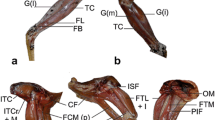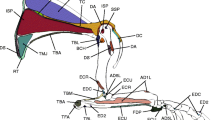Abstract
The limbs of elephants are designed to support the weight of the largest terrestrial animal, and they display unique morphological peculiarities among mammals. In this article we provide a new and detailed anatomical description of the muscles of the lower hindlimb in African elephants (Loxodonta africana), and we place our observations into a comparative anatomical as well as a functional morphological context. At the cranial aspect of the shank (crus) and the foot (pes), the flexors of the tarsal joint and the extensors of the toes form a flat muscular plate covering the skeletal elements. Caudal to the tibia and the fibula the Musculus (M.) soleus is strongly developed, whereas the M. gastrocnemius and the M. flexor digitorum superficialis are thin. Small flexors, adductors, and abductors of the toes are present. The M. tibialis caudalis as well as the Mm. fibularis longus and brevis mainly support the tarsal joint. The design of the muscular structures matches the specific requirements of heavy-weight bearing as well as of proboscidean limb posture and locomotion patterns.



Similar content being viewed by others
References
Alexander RMcN, Maloiy GMO, Hunter B, Jayes AS, Nturibi J (1979) Mechanical stresses in fast locomotion of buffalo (Syncerus caffer) and elephant (Loxodonta africana). J Zool 189:135–144
Bardeleben K (1890) Über die Hand- und Fuss-Muskeln der Säugetiere, besonders die des Praepollex (Praehallux) und Postminimus. Anat Anz 16/17:435–444
Chapple CR, Wood BA (1980) Venous drainage of the hind limb in the monkey (Macaca fascicularis). J Anat 131:157–171
Davis DD (1964) The giant panda—a morphological study of evolutionary mechanisms. In: Ross LA, Williams PM, Nash EG (eds) Fieldiana: zoology memoirs, vol. 3. Chicago Natural History Museum, Chicago
Eales NB (1928) The anatomy of a foetal African elephant, Elephas africanus (Loxodonta africana). Part II. The body muscles. Trans Roy Soc Edinburgh 55:609–642
Fischer MS (1983) Die Extremitätenmuskulatur der Hyracoidea. Diplomarbeit, Fakultät für Biologie der Universität Tübingen
Fischer MS (1986) Die Stellung der Schliefer (Hyracoidea) im phylogenetischen System der Eutheria. Courier Forschungsinstitut Senckenberg 84:1–132
Fowler ME (2001) An overview of foot conditions in Asian and African elephants. In: Csuti B, Sargent EL, Bechert US (eds) The elephant’s foot. Iowa state University Press, Ames, IA, pp 3–7
Frey H (1913) Der Musculus triceps surae in der Primatenreihe. Morphol Jb 47:1–191
Glaesmer E (1910) Die Beugemuskeln am Unterschenkel und Fuß bei den Marsupialia, Insectivora, Edentata, Prosimiae und Simiae. Morphol Jb 41:149–336
Henry RW, Orosz SE (1988) The muscles of the crus of the African elephant (Loxodonta africana). Anat Histol Embryol 17:370
Hutchinson JR, Famini D, Lair R, Kram R (2003) Are fast-moving elephants really running? Nature 422:493–494
Ker RF, Bennett MB, Bibby SR, Kester RC, Alexander RMcN (1987) The spring in the arch of the human foot. Nature 325:147–149
König HE, Macher R, Polsterer-Heindl E, Sora CM, Hinterhofer C, Helmreich M, Böck P (2003) Stoßbrechende Einrichtungen am Zehenendorgan des Pferdes. Wiener Tierärztliche Monatsschrift 90:267–273
Kriegler W (1961) Zur Myologie des Beckens und der Hinterextremität der Reptilien. Morphol Jb 101:541–625
Lewis OJ (1962) The phylogeny of the crural and pedal flexor musculature. Proc Zool Soc London 138:77–109
Lewis OJ (1963) The monotreme cruro-pedal flexor musculature. J Anat 97: 55–63
Lewis OJ (1964) The tibialis posterior tendon in the primate foot. J Anat 98:209–218
Mariappa D (1955) The anatomy of a foetal Indian elephant. Part IV. The muscles, nerves and blood vessels of the hind limb and tail. Indian Vet J 32:407–430
Mariappa D (1986) Anatomy and histology of the Indian elephant. Indira, Oak Park, Michigan
Miall LC, Greenwood F (1878) The anatomy of the Indian elephant. Part I. The muscles of the extremities. J Anat Physiol 12:261–287
Nicolier A (2001) Anatomie topographique du membre pelvien de l’ours brun (Ursus arctos). Thèse, Ecole Nationale Veterinaire de Lyon
Nomina Anatomica Veterinaria, 4th edn (1994) International Committee on Veterinary Gross Anatomical Nomenclature and World Association of Veterinary Anatomists, Zürich
Pavelka R (1971) Die peripheren Leitungsbahnen an der hinteren Extremität bei Elephas maximus. Anat Anz 128:150–169
Preuschoft H (1961) Muskeln und Gelenke der Hinterextremität des Gorillas (Gorilla gorilla Savage et Wyman, 1847). Morphol Jb 101:430–540
Ramsay EC, Henry RW (2001) Anatomy of the elephant foot. In: Csuti B, Sargent EL, Bechert US (eds) The elephant’s foot. Iowa State University Press, Ames, IA, pp 9–12
Raven HC (1936) Comparative anatomy of the sole of the foot. Am Mus Nov 871:1–9
Ribbing L (1938) Die Muskeln und Nerven der Extremitäten. In: Bolk L, Göppert E, Kallius E, Lubosch W (eds) Handbuch der vergleichenden Anatomie der Wirbeltiere, fünfter Band. Urban und Schwarzenberg, Berlin, pp 543–682
Ruge G (1878) Untersuchung über die Extensorengruppe am Unterschenkel und Fusse der Säugethiere. Morphol Jb 4:592–643
Schaller O (1992) Illustrated veterinary anatomical nomenclature. Enke, Stuttgart
Schwerda D (2003) Analyse kinematischer Parameter der Lokomotion von Loxodonta africana (Proboscidea: Elephantidae). Diplomarbeit, Institut für Spezielle Zoologie und Evolutionsbiologie mit Phyletischem Museum der Friedrich-Schiller-Universität Jena
Seiferle E, Frewein S (1992) Aktiver Bewegungsapparat, Muskelsystem, Myologia. In: Nickel R, Schummer A, Seiferle E, Frewein J, Wille KH, Wilkens H (eds) Lehrbuch der Anatomie der Haustiere, Band 1, 6. Auflage. Paul Parey, Berlin, pp 273–585
Shindo T, Mori M (1956) Musculature of the Indian elephant. Part II. Musculature of the hindlimb. Okajimas Folia Anatomica Japonica 28:114–147
Smuts MMS, Bezuidenhout AJ (1994) Osteology of the pelvic limb of the African elephant (Loxodonta africana). Onderstepoort J Vet Res 61:55–66
Federative Committee on Anatomical Terminology (1998) Terminologia Anatomica. Thieme, Stuttgart
Tillmann B (2003) Untere Extremität. In: Leonhardt H, Tillmann B, Töndury G, Zilles K (eds) Anatomie des Menschen, Band I, Bewegungsapparat, 3. Auflage. Thieme, Stuttgart, pp 445–651
Weissengruber GE, Forstenpointner G, Gangl D (2003) Gut zu Fuß—funktionell-anatomische Aspekte des bipeden Laufens beim Afrikanischen Strauß (Struthio camelus Linné, 1758). Wiener Tierärztliche Monatsschrift 90:67–78
Windle BCA, Parsons FG (1898) The myology of the terrestrial carnivora—part II. Proc Zool Soc London:152–186
Windle BCA, Parsons FG (1903) On the muscles of the ungulata. Part II—Muscles of the hind-limb and trunk. Proc Zool Soc London:261–298
Yang F, Alkalaeva EZ, Perelman PL, Pardini AT, Harrison WR, O’Brien PCM, Fu B, Graphodatsky MA, Ferguson-Smith MA, Robinson TJ (2003) Reciprocal chromosome painting among human, aardvark, and elephant (superorder Afrotheria) reveals the likely eutherian ancestral caryotype. PNAS 100:1062–1066
Zuckerkandl E (1911) Über die Extremitätenarterien des afrikanischen Elefanten. Sitzungsberichte der mathematisch-naturwissenschaftlichen Klasse der Kaiserlichen Akademie der Wissenschaften, Wien, 120 (III):315–329
Acknowledgements
We wish to thank Mag. med. vet. Eva Polsterer (Vienna, Austria) for excellent artwork, and Prof. Herman B. Groenewald, Prof. John T. Soley, and Mr. Leon de Villiers (Department of Anatomy and Physiology, Faculty of Veterinary Science, University of Pretoria, Onderstepoort, South Africa) for outstanding scientific cooperation and great hospitality. We are grateful to Mr. Leo Habeler and Mr. Helmut Dier (Department of Pathobiology, Anatomy, University of Veterinary Medicine, Vienna, Austria) for skilled technical assistance. A research grant from the Gesellschaft der Freunde der Veterinärmedizinischen Universität Wien aided this study.
Author information
Authors and Affiliations
Corresponding author
Rights and permissions
About this article
Cite this article
Weissengruber, G.E., Forstenpointner, G. Musculature of the crus and pes of the African elephant (Loxodonta africana): insight into semiplantigrade limb architecture. Anat Embryol 208, 451–461 (2004). https://doi.org/10.1007/s00429-004-0406-1
Accepted:
Published:
Issue Date:
DOI: https://doi.org/10.1007/s00429-004-0406-1




